China's first aircraft carrier has returned to its home port after a series of training exercises in the South China Sea.
It was the Liaoning's first long-distance training mission since being commissioned last year, raising concerns in the West and several nations with territorial spats with the country about China's growing naval power.
The official Xinhua news agency said the refurbished Soviet carrier "underwent a comprehensive test of its combat system and conducted a formation practice."
Xinhua quoted unnamed naval sources as saying the 37-day trip "attained the anticipated objectives," and that all tests "went well as scheduled."
Zhang Zheng, the Liaoning's captain, reported that the mission went smoothly.
"We tried to integrate the test, training and combat of the aircraft carrier during this scientific research and training in the South China Sea. And we focused on the research of its safeguard and combat abilities," said Zhang.
The Liaoning was escorted by aircraft, warships and submarines that also participated in the tests.
On December 5, one of the Chinese warships escorting the Liaoning narrowly avoided colliding with a U.S. naval vessel. U.S. officials say the USS Cowpens was forced to take evasive action to avoid hitting the Chinese vessel.
Pentagon chief Chuck Hagel later said China acted in an "irresponsible" manner during the stand-off, which occurred as the U.S. ship monitored the Chinese carrier group in international waters.
Beijing, however, said it acted "in accordance with strict protocol," and suggested the U.S. ship had ignored warnings and come too close to the Chinese carrier.
Carl Thayer with Australia's University of New South Wales says the issue is that China "has a different interpretation of international law and what's permissible on the high seas or international waters."
Thayer told VOA that China should work with the U.S. to establish appropriate rules of behavior in intelligence gathering, much like Washington did with Moscow during the Cold War.
"This sort of intelligence gathering is stable when countries face each other and have nuclear weapons. I think that the Soviet Union and the United States appreciated that. And China.... has also got to learn to be a bit more sophisticated I think with how it's going to relate with the United States in military operations at sea to prevent these incidents," said Thayer.
Thayer also pointed out that Beijing is not seeking out clashes with the U.S., but that it hopes to use its growing naval strength to keep U.S. forces as far as possible from its mainland.
For its part, China has described the Liaoning's role as "experimental."
Peter Dean of the Australian National University's Strategic and Defense Studies Center told VOA the carrier is only half the size of the United States' new Gerald Ford-class super carriers. However, he also noted that the carrier should be seen as representative of China's wider ambitions.
"It's linked to their trade and ability to exert more power around the region. And as one of the Chinese admirals recently said, aircraft carriers are what great powers have. And China very much sees itself as coming into this stage of its development as a great international power," explained Dean.
Many of China's neighbors are concerned about its rising status, and accuse it of being more aggressive in recent years in defending its maritime claims.
China's choice of the South China Sea as the location to conduct the Liaoning's first long-term training mission seemed to do little to calm those concerns, since Beijing has territorial disputes with several of its neighbors there.

